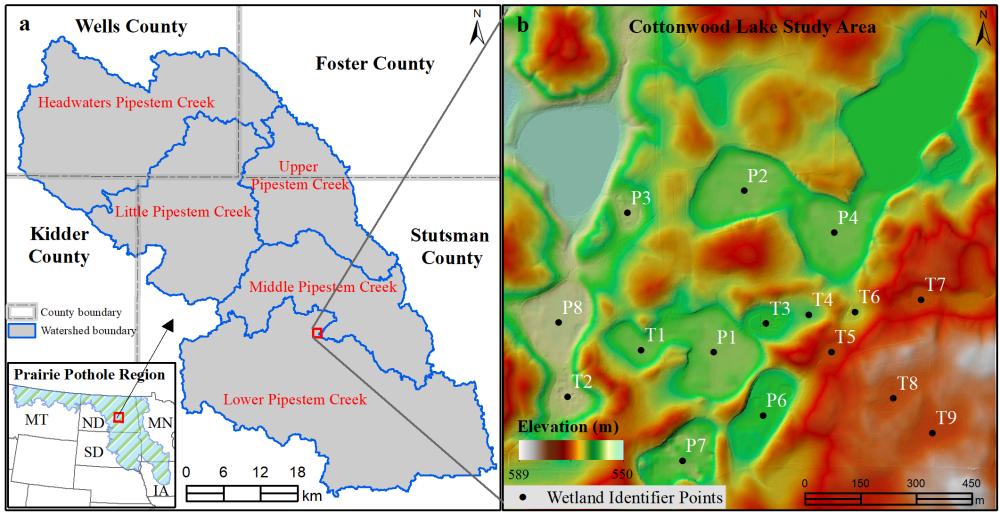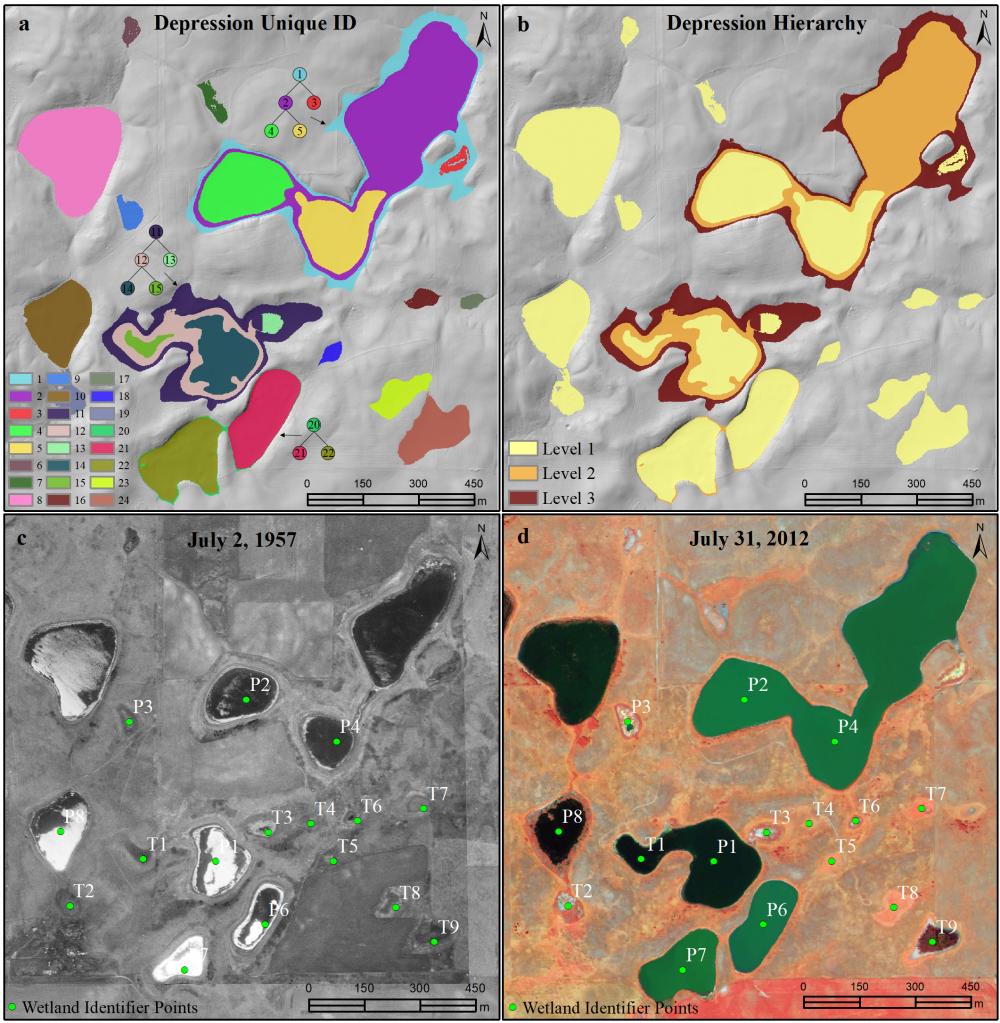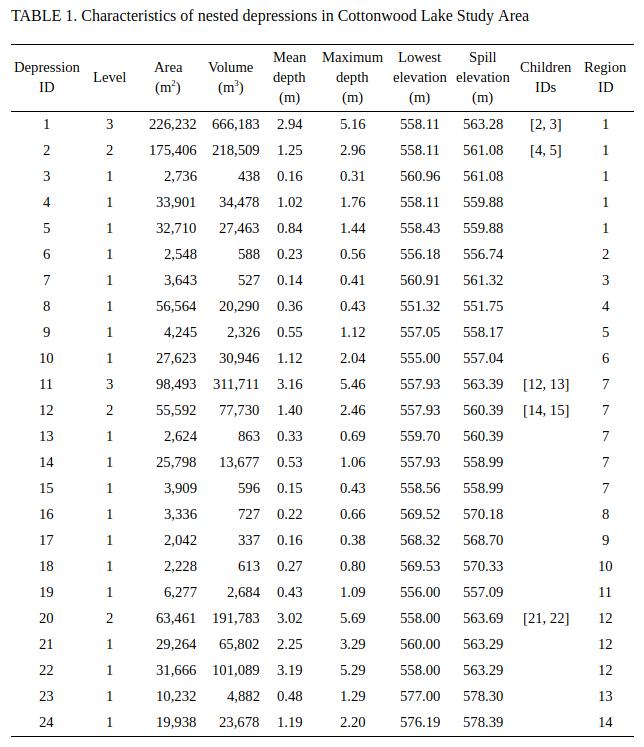



Author: Qiusheng Wu (https://wetlands.io)
lidar is a toolset for terrain and hydrological analysis using digital elevation models (DEMs). It is particularly useful for analyzing high-resolution topographic data, such as DEMs derived from Light Detection and Ranging (LiDAR) data.
- GitHub repo: https://github.com/giswqs/lidar
- Documentation: https://lidar.readthedocs.io.
- PyPI: https://pypi.org/project/lidar/
- Binder: https://gishub.org/lidar-cloud
- Free software: MIT license
Contents
- Smoothing DEMs using mean, median, and Gaussian filters (see filtering.py)
- Extracting depressions from DEMs (see filling.py).
- Filtering out small artifact depressions based on user-specified minimum depression size (see filling.py).
- Generating refined DEMs with small depressions filled but larger depressions kept intact (see filling.py).
- Delineating depression nested hierarchy using the level-set method (see slicing.py).
- Delineating mount nested hierarchy using the level-set method (see mounts.py).
- Computing topological and geometric properties of depressions, including size, volume, mean depth, maximum depth, lowest elevation, spill elevation, perimeter, major axis length, minor axis length, elongatedness, eccentricity, orientation, and area-bbox-ratio (see slicing.py).
- Exporting depression properties as a csv file (see slicing.py).
lidar supports a variety of platforms, including Microsoft Windows, macOS, and Linux operating systems. Note that you will need to have Python 3.x installed. Python 2.x is not supported. The lidar Python package can be installed using the following command. If you encounter any errors, please check the Dependencies section below. The instruction below assumes that you have installed Anaconda. Open Anaconda Prompt and enter the following commands to create a conda environment and install required packages.
conda create -n py37 python=3.7
conda activate py37
conda install -c conda-forge gdal
pip install lidarIf you have installed lidar before and want to upgrade to the latest version, you can use the following command:
pip install lidar -ULaunch the interactive notebook tutorial for the lidar Python package with mybinder.org or binder.pangeo.io now:
import os
import pkg_resources
from lidar import *
# identify the sample data directory of the package
package_name = 'lidar'
data_dir = pkg_resources.resource_filename(package_name, 'data/')
# use the sample dem. Change it to your own dem if needed
in_dem = os.path.join(data_dir, 'dem.tif')
# set output directory. By default, use the temp directory under user's home directory
out_dir = os.path.join(os.path.expanduser("~"), "temp")
# parameters for identifying sinks and delineating nested depressions
min_size = 1000 # minimum number of pixels as a depression
min_depth = 0.5 # minimum depth as a depression
interval = 0.3 # slicing interval for the level-set method
bool_shp = True # output shapefiles for each individual level
# extracting sinks based on user-defined minimum depression size
out_dem = os.path.join(out_dir, "median.tif")
in_dem = MedianFilter(in_dem, kernel_size=3, out_file=out_dem)
sink_path = ExtractSinks(in_dem, min_size, out_dir)
dep_id_path, dep_level_path = DelineateDepressions(sink_path, min_size, min_depth, interval, out_dir, bool_shp)
print('Results are saved in: {}'.format(out_dir))Check the example.py for more details.
This tutorial can be accessed in three ways:
- HTML version: https://gishub.org/lidar-html
- Viewable Notebook: https://gishub.org/lidar-notebook
- Interactive Notebook: https://gishub.org/lidar-cloud
Launch this tutorial as an interactive Jupyter Notebook on the cloud - https://gishub.org/lidar-cloud.
lidar also provides a Graphical User Interface (GUI), which can be invoked using the following Python script:
import lidar
lidar.gui()lidar's Python dependencies are listed in its requirements.txt file. In addition, lidar has a C library dependency: GDAL >=1.11.2. How to install GDAL in different operating systems will be explained below. More informaton about GDAL can be found here.
It is highly recommended that you use a Python virtual environment (e.g., conda) to test the lidar package. Please follow the conda user guide to install conda if necessary. Once you have conda installed, you can use Terminal or an Anaconda Prompt to create a Python virtual environment. Check managing Python environment for more information.
Once GDAL has been installed, you can then proceed to install the lidar Python package using the following command:
conda create -n py37 python=3.7
conda activate py37
conda install -c conda-forge gdal
pip install lidarThe following commands can be used to install GDAL for Debian-based Linux distributions (e.g., Ubuntu, Linux Mint).
sudo add-apt-repository ppa:ubuntugis/ppa
sudo apt-get update
sudo apt-get install gdal-bin libgdal-dev
pip install lidarIf you encounter any compiling errors, try the following commands.
sudo apt-get install --reinstall build-essential
sudo apt-get install python3-dev
pip install wheelThe following commands can be used to install GDAL for Pacman-based Linux distributions (e.g., Arch Linux, Manjaro). You might need to use sudo if you encounter permission errors.
sudo pacman -S yaourt --noconfirm
yaourt -S gdal --noconfirm
yaourt -S python-gdal --noconfirm
pip install lidarFor a Homebrew based Python environment, do the following.
brew update
brew install gdalAlternatively, you can install GDAL binaries from kyngchaos. You will then need to add the installed location /Library/Frameworks/GDAL.framework/Programs to your system path.
The instruction below assumes that you have installed Anaconda. Open Anaconda Prompt and enter the following commands to create a conda environment and install required packages
conda create -n py37 python=3.7
conda activate py37
conda install -c conda-forge gdal
pip install richdem
pip install lidarWhen installing the richdem package, if you encounter an error saying 'Microsoft Visual C++ 14.0 is required', please follow the steps below to fix the error and reinstall richdem. More infomration can be found at this link Fix Python 3 on Windows error - Microsoft Visual C++ 14.0 is required.
- Download Microsoft Build Tools for Visual Studio 2017
- Double click to install the downloaded installer - Microsoft Build Tools for Visual Studio 2017.
- Open Microsoft Build Tools for Visual Studio 2017
- Select Workloads --> Visual C++ build tools and click the install button
The images below show working examples of the level set method for delineating nested depressions in the Cottonwood Lake Study Area (CLSA), North Dakota. More test datasets (e.g., the Pipestem watershed in the Prairie Pothole Region of North Dakota) can be downloaded from http://gishub.org/2018-JAWRA-Data
The following example was conducted on a 64-bit Linux machine with a quad-core Intel i7-7700 CPU and 16 GB RAM. The average running time of the algorithm for this DEM was 0.75 seconds.
The level-set algorithm in the lidar package has been published in the following article:
- Wu, Q., Lane, C.R., Wang, L., Vanderhoof, M.K., Christensen, J.R., & Liu, H. (2019). Efficient Delineation of Nested Depression Hierarchy in Digital Elevation Models for Hydrological Analysis Using Level-Set Method. Journal of the American Water Resources Association. DOI: 10.1111/1752-1688.12689 (preprint)
Applications of the level-set and contour-tree methods for feature extraction from LiDAR data:
- Wu, Q., & Lane, C.R. (2017). Delineating wetland catchments and modeling hydrologic connectivity using LiDAR data and aerial imagery. Hydrology and Earth System Sciences. 21: 3579-3595. DOI: 10.5194/hess-21-3579-2017
- Wu, Q., Deng, C., & Chen, Z. (2016). Automated delineation of karst sinkholes from LiDAR-derived digital elevation models. Geomorphology. 266: 1-10. DOI: 10.1016/j.geomorph.2016.05.006
- Wu, Q., Su, H., Sherman, D.J., Liu, H., Wozencraft, J.M., Yu, B., & Chen, Z. (2016). A graph-based approach for assessing storm-induced coastal changes. International Journal of Remote Sensing. 37:4854-4873. DOI: 10.1080/01431161.2016.1225180
- Wu, Q., & Lane, C.R. (2016). Delineation and quantification of wetland depressions in the Prairie Pothole Region of North Dakota. Wetlands. 36(2):215–227. DOI: 10.1007/s13157-015-0731-6
- Wu, Q., Liu, H., Wang, S., Yu, B., Beck, R., & Hinkel, K. (2015). A localized contour tree method for deriving geometric and topological properties of complex surface depressions based on high-resolution topographic data. International Journal of Geographical Information Science. 29(12): 2041-2060. DOI: 10.1080/13658816.2015.1038719
- Wu, Q., Lane, C.R., & Liu, H. (2014). An effective method for detecting potential woodland vernal pools using high-resolution LiDAR data and aerial imagery. Remote Sensing. 6(11):11444-11467. DOI: 10.3390/rs61111444
Report bugs at https://github.com/giswqs/lidar/issues.
If you are reporting a bug, please include:
- Your operating system name and version.
- Any details about your local setup that might be helpful in troubleshooting.
- Detailed steps to reproduce the bug.
- The algorithms are built on richdem, numpy, scipy, scikit-image, and pygdal.
- This package was created with Cookiecutter and the audreyr/cookiecutter-pypackage project template.




